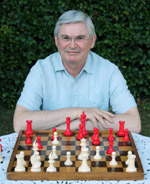Our website is made possible by displaying online advertisements to our visitors.
Please consider supporting us by disabling your ad blocker.
Alan Fersht
| Alan Fersht | |
|---|---|

30. juli 2008 | |
| Personlig information | |
| Født | 21. april 1943 (81 år) Hackney, Storbritannien |
| Uddannelse og virke | |
| Uddannelsessted | University of Cambridge (til 1968), Sir George Monoux College, Gonville and Caius College |
| Medlem af | Royal Society (fra 1983), European Molecular Biology Organization, National Academy of Sciences (fra 1993), Academia Europaea (fra 1989), American Academy of Arts and Sciences |
| Beskæftigelse | Universitetsunderviser, biokemiker, kemiker |
| Fagområde | Onkologi, biokemi |
| Arbejdsgiver | Imperial College London |
| Nomineringer og priser | |
| Udmærkelser | Feldberg Foundation (1996), Fellow of the Royal Society, Davy-medalje (1998), Fellow of the Academy of Medical Sciences, EMBO-medlemskab med flere |
| Eksterne henvisninger | |
| Alan Fershts hjemmeside | |
| Information med symbolet | |
Sir Alan Roy Fersht FRS FMedSci[1] (født 21. april 1943) er en britisk kemiker ved Laboratory of Molecular Biology og professor Emeritus ved Department of Chemistry på University of Cambridge;[2] og tidligere Master for Gonville and Caius College, Cambridge.[3][4][5][6][7][8][9] Han har forsket i proteinfoldning.[10][11][12][13][14][15][16][17]
- ^ "Professor Sir Alan Fersht FRS FMedSci". Academy of Medical Sciences. Arkiveret fra originalen 17. april 2015.
- ^ "Professor Sir Alan Fersht FRS, Department of Chemistry, University of Cambridge". Hentet 26. juli 2011.
- ^ "Professor Sir Alan Fersht FRS becomes the 42nd Master of Caius". Arkiveret fra originalen 22. april 2015. Hentet 21. november 2012.
- ^ Europabio: profile (Webside ikke længere tilgængelig)
- ^ BBC: brief Fersht career summary at time of knighthood
- ^ "Imperial College London: biographical summary Alan Fersht". Arkiveret fra originalen 27. juni 2009.
- ^ "Fersht webpage at MRC Laboratory of Molecular Biology, Cambridge UK". Arkiveret fra originalen 14. september 2014.
- ^ Skabelon:Scopus
- ^ Fersht, A. R. (2013). "Profile of Martin Karplus, Michael Levitt, and Arieh Warshel, 2013 nobel laureates in chemistry". Proceedings of the National Academy of Sciences of the United States of America. 110 (49): 19656-7. Bibcode:2013PNAS..11019656F. doi:10.1073/pnas.1320569110. PMC 3856823. PMID 24277833.
- ^ Jackson, S. E.; Fersht, A. R. (1991). "Folding of chymotrypsin inhibitor 2. 1. Evidence for a two-state transition". Biochemistry. 30 (43): 10428-10435. doi:10.1021/bi00107a010. PMID 1931967.
- ^ Fersht, A. R.; Shi, J. P.; Knill-Jones, J.; Lowe, D. M.; Wilkinson, A. J.; Blow, D. M.; Brick, P.; Carter, P.; Waye, M. M. Y.; Winter, G. (1985). "Hydrogen bonding and biological specificity analysed by protein engineering". Nature. 314 (6008): 235-238. Bibcode:1985Natur.314..235F. doi:10.1038/314235a0. PMID 3845322. S2CID 32388197.
- ^ Matouschek, A.; Kellis, J. T.; Serrano, L.; Fersht, A. R. (1989). "Mapping the transition state and pathway of protein folding by protein engineering". Nature. 340 (6229): 122-126. Bibcode:1989Natur.340..122M. doi:10.1038/340122a0. PMID 2739734. S2CID 4302226.
- ^ Fersht, A.; Matouschek, A.; Serrano, L. (1992). "The folding of an enzyme I. Theory of protein engineering analysis of stability and pathway of protein folding". Journal of Molecular Biology. 224 (3): 771-782. doi:10.1016/0022-2836(92)90561-W. PMID 1569556.
- ^ Fersht, Alan (1999). Structure and mechanism in protein science: a guide to enzyme catalysis and protein folding. San Francisco: W.H. Freeman. ISBN 0-7167-3268-8.
- ^ Wilkinson, A. J. (2010). "The Selected Papers of Sir Alan Fersht: Development of Protein Engineering". Protein Engineering Design and Selection. 24 (1-2): 225-227. doi:10.1093/protein/gzq103.
- ^ Qinghua Wang; Fersht, Alan (2010). Selected Papers of Sir Alan Fersht: The Development of Protein Engineering (Icp Selected Papers). River Edge, N.J: Imperial College Press. ISBN 978-1-84816-554-0.
- ^ Fersht, Alan (1985). Enzyme structure and mechanism. San Francisco: W.H. Freeman. ISBN 0-7167-1614-3.
Previous Page Next Page


